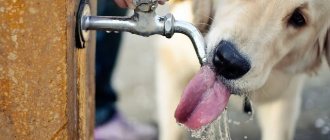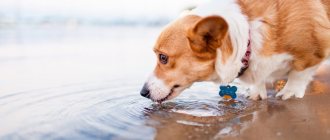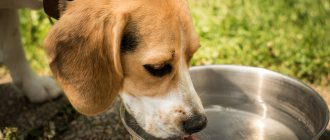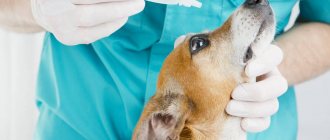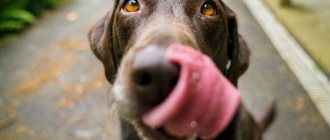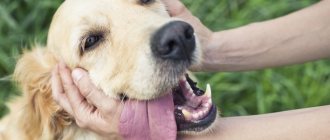For any living organism, the need for water is always higher than for food. Without it, death occurs much faster, so veterinarians strongly recommend monitoring the amount you drink. But deviation from the norm is dangerous not only to a lesser extent, but also to a greater extent.
Due to an increase in the volume of alcohol consumed, uncontrolled thirst (polydipsia) is often accompanied by frequent and profuse urination. If you notice these symptoms, you need to find out as soon as possible why your dog is drinking a lot of water and urinating frequently. Some causes of these disorders can be fatal.
Drinking norm for four-legged animals
On average, the drinking norm is about 100 ml per 1 kg of weight. It may deviate upward or downward depending on the following factors:
- Dimensions
. Small breeds always drink less than large breeds.
- Age
. With aging, metabolic processes slow down, so maintaining the functionality of internal organs requires less moisture.
- Floor
. Bitches require more fluid, since pregnancy and lactation account for the main consumption.
- Type of diet
. Part of the moisture enters the body from foods. With natural feeding, animals replenish 60-80% of their drinking norm, and with dry feeding - only 8-12%. The rest must be supplemented with fresh water.
You can calculate the amount you drink using a measuring cup. Replace your regular bowl with it and examine the remaining contents at the end of the day. Do not forget to exclude from the calculation what evaporated naturally and what was drunk with food (liquid cereals, broths, fermented milk products).
If a puppy pees
If your puppy urinates frequently, don't scold him. After all, only at 3-4 months will he be able to learn to control this process. The training period may increase if the owner of the four-legged friend cannot correctly explain when and how to do this to the puppy. It is necessary to suggest where to relieve yourself.
If the puppy is already six months old, and he continues to urinate, then you need to think about the seriousness of the situation - perhaps your pet is simply sick, or maybe he has bad heredity. And if this is the reason, then only surgery will help him.
Why does a dog drink a lot of water: non-dangerous reasons
Non-dangerous causes of thirst in a dog include anything that does not pose a threat to its life. In such cases, treatment is not required. The condition returns to normal on its own - after the disappearance of the provoking factor.
Hot and dry weather
The most common reasons for thirst are high temperatures outside and in the room, as well as a low percentage of humidity characteristic of the heating season. Overheating and lack of air can be determined by rapid breathing and protruding tongue.
Salty or dry food
If a dog drinks a lot, its thirst may be due to too salty or dry food. Salt draws water from the body, so its excess in the diet is fraught with dehydration and problems with the gastrointestinal tract. For this reason, veterinarians do not recommend feeding your pet sausage and other delicacies from the human table.
Also, do not forget that for comfortable digestion of dry granules, much more liquid is required than for regular products. They are practically devoid of moisture, so when switching to dry feeding, the animal has to drink more than usual.
Taking medications
Thirst is a side symptom of taking certain medications. These include diuretics, anticonvulsants and glucocorticosteroids. After the end of treatment, the condition returns to normal.
Increased physical activity
Loss of moisture through sweating occurs not only in hot weather, but also during increased physical activity. You shouldn’t be surprised if your dog drinks heavily and for a long time after an intense workout on apparatus. He just needs to replenish his water balance.
Coming out of anesthesia
Shortly after spaying or neutering, animals literally attack their water bowl. This helps them remove the remnants of anesthesia, which is a toxin for the body.
Replacing food with water during a fast
To prepare for operations under full anesthesia and for some tests, it is recommended to completely empty the stomach. 12 hours before the intervention, the quadruped is deprived of any food to avoid aspiration pneumonia due to sudden vomiting or abnormal test results. But the feeling of hunger does not disappear during this period, so the poor fellow has to be content with ordinary water.
Treatment
You should be careful here, since at home it is difficult to understand what exactly is happening to the animal.
When dehydration occurs, it is important to find out and eliminate the cause. All you can do is not restrict the animal from water and show it to the veterinarian.
In case of poisoning, it is very important to act quickly. The most effective treatment is in the first 12 hours. The first thing to do is to cleanse the stomach (induce vomiting) using specialized emetics, or you can use regular hydrogen peroxide.
Be sure to dilute it with water so as not to cause a burn to the mucous membranes! Inject directly into the throat.
You can also use Vaseline oil. After washing the stomach, we give sorbents to remove toxins from the body. This can be Enterosgel or Polysorb. Further actions and choice of drugs depend on the substance that caused the poisoning.
Treatment of endocrine disorders consists of hormone therapy under the strict supervision of a veterinarian.
Problems of the genitourinary system should be treated as prescribed by a veterinarian in each individual case. The main thing is not to limit your dog’s drinking. Special diets of food from the “Urinari” line are also prescribed.
If you are dealing with liver disease , the challenge is to find and prevent the cause. And the liver itself will recover perfectly as soon as the pathological factor is eliminated.
Do not self-medicate; be sure to show the animal to a specialist.
Pathological causes associated with diseases
Dogs drink a lot of water and urinate not only due to external factors, but also due to internal pathologies. They can be recognized by accompanying symptoms and a stable deterioration in general condition.
Diabetes
With diabetes mellitus, an artificial lack of sugar occurs in the body. Incoming glucose is not absorbed and is excreted in the urine. It draws out some of the free fluid behind it, so the daily volume of urine and the need for water increase. A sick animal constantly wants to eat, but still remains hungry and loses weight.
Kidney failure
Pain during urination and changes in the color of urine are very alarming signs characteristic of kidney problems. Unlike the liver, this organ does not know how to recover. If you suspect kidney failure or urolithiasis, you should immediately contact your veterinarian.
Genitourinary pathologies
Other diseases of the genitourinary system have symptoms similar to kidney pathologies. These include urocystitis, urethritis, endometriosis and pyometra. They are united by the obligatory presence of an inflammatory process. A sick animal refuses to eat, but drinks much more than usual.
Disruptions of hormones and endocrine system
Hormonal disruptions and disturbances in the functioning of the endocrine system lead to the development of diabetes insipidus, Cushing's syndrome, hypercalcemia, hypothyroidism and Addison's disease. All these pathologies are united by increased thirst, so an accurate diagnosis can only be found out after testing.
Fever due to infections
A dog drinks a lot if its body temperature is above normal. Fever often accompanies infections. Thanks to plenty of drinking, the body not only cools itself, but also removes accumulated toxins.
Liver pathologies
Liver problems can be recognized by yellowed mucous membranes or skin, as well as darkened urine and lightened stool. This organ, like the kidneys, performs a filtering function. If at least part of the hepatocytes is damaged, waste products begin to linger inside the body, so more and more fluid is required to remove them.
Poisoning
If the dog does not eat and drinks a lot, then it makes sense to suspect poisoning. Toxins that enter the body through food, poisons or chemicals cause acute vomiting and diarrhea. The body quickly becomes dehydrated, so to normalize the water-salt balance and remove harmful substances, the animal has to constantly drink.
Dehydration
Dehydration occurs with prolonged diarrhea, repeated vomiting and heavy blood loss. It is not the root cause of thirst and is always only a consequence of a more dangerous disorder.
Infection with worms
Another possible cause of intoxication is helminthiasis. As a result of their vital activity, parasites release a huge amount of harmful substances, poisoning the animal’s body with them. Despite increased thirst and appetite, weight continues to fall as all the nutrients are absorbed by the worms.
Diseases accompanied by increased thirst
Diseases accompanied by increased thirst almost always manifest themselves acutely and threaten the life of the animal. Polydipsia is the scientific name for uncontrollable thirst in animals and humans.
Below are just some of the diseases that may be accompanied by polydipsia:
- Purulent inflammation of the uterus (pyometra) in bitches.
- Intoxication of the body (poisoning).
- Diabetes mellitus and diabetes insipidus.
- Diseases of the kidneys and genitourinary system.
- Dehydration.
- Bleeding, including internal.
- Fever (increased body temperature).
- Tumors.
- Injury.
- Stress.
- Inflammatory processes in the brain.
- Burns.
- Thyrotoxicosis (hyperfunction of the thyroid gland).
- Mental disorders.
Note! Polydipsia can be a consequence of taking certain medications.
What accompanying symptoms should alert you?
If none of the non-dangerous reasons are suitable, study the accompanying signs. Pathology should be suspected if the following symptoms appear:
- depression, drowsiness, causeless aggression and loss of appetite;
- increase or decrease in temperature;
- changes in the color, consistency, or odor of urine or stool;
- pain when urinating;
- repeated vomiting and diarrhea;
- purulent discharge from the eyes;
- abdominal enlargement and swelling;
- sudden loss or gain of excess weight;
- yellowing of mucous membranes and skin;
- rapid and noisy breathing.
If the listed symptoms appear, the pet must be taken to a veterinary clinic. Before making a diagnosis, avoid self-medication so as not to worsen the existing condition and blur the clinical picture.
Consequences of not drinking
If your dog is eating but not getting enough water, this can lead to a number of serious problems. Possible consequences:
- decreased activity, lethargy and lethargy;
- change in skin tone;
- deterioration of joint function, pain when walking;
- disruption of the functioning of all internal organs;
- slowing down metabolism;
- departure against the background of stagnation of toxins in the body;
- development of chronic diseases.
A prolonged absence of water leads to severe exhaustion of the animal. If the necessary measures are not taken in time, this can result in death. This is why it is important to respond to signs of dehydration as quickly as possible, especially if you have an older dog.
Diagnosis at the veterinarian
After examination, a general and chemical blood test must be taken from the four-legged patient. All other studies are prescribed individually, based on the overall picture. These may include:
- clinical and bacteriological analysis of urine;
- Ultrasound;
- X-ray;
- CT and MRI;
- washes and smears.
After receiving all the results, the veterinarian determines the exact reason why the dog drinks water frequently. Based on this, further treatment is selected.
Prevention
To prevent possible diseases, you need:
- carefully monitor the dog’s condition;
- provide her with the amount of water she needs;
- monitor the quality of food; if you feed natural food, ensure a balanced diet;
- Visit your veterinarian periodically to check your pet's health.
What should the owner do?
The main task of the owner is to eliminate the factor that provokes polydipsia. In case of pathology, the pet is given special medications and a therapeutic diet. In all other cases, it is enough to simply change the conditions of detention and adjust the existing diet.
Begin treatment under the guidance of a veterinarian
The method of treatment depends entirely on the disease. The animal may be prescribed antibiotics, anthelmintics, hepatoprotectors, hormonal or other drugs, as well as gastric lavage, infusion therapy or emergency surgery.
If your pet is diabetic, your pet will need insulin injections for life. This is the only way he can avoid relapses and live a full life.
Take your pet for a walk more often
Frequent and active walks will help avoid obesity. Excess weight puts a lot of stress on internal organs, impairing their functionality. For this reason, the couch lifestyle should not be encouraged.
Provide comfortable living conditions
It is necessary to take care of a sufficient level of humidity, comfortable temperature and cleanliness. It is recommended to place your pet's sleeping place away from drafts and tiled floors to reduce the likelihood of developing a cold.
Put the animal on a diet
The therapeutic diet is selected by the veterinarian based on the diagnosis. The easiest way is to switch to a special line of dry food.
When eating a natural diet, you should limit your salt intake and exclude all prohibited foods. Before recovery, it is better to serve food in ground form to reduce the load on the gastrointestinal tract.
Injuries
It happens that frequent urination occurs due to pathologies of the spinal column. They are characterized by injury to nerve endings or the spinal canal. It is almost impossible to cure this, at least completely. Usually dogs with an elongated spine suffer from this, for example, dachshunds.
During or after whelping, these dogs sometimes experience nerve compression. This phenomenon is characterized by lethargy of the animal, lack of strength in the paws, and refusal of its own puppy. The doctor will be able to prescribe a combination treatment after diagnosis.
If the doctor insists on surgery, you should not agree right away; let him conduct special tests and prescribe medications.
First aid at home
Even with a single vomiting attack, there is no need to scold your furry friend - remember that the reverse reaction is not controlled, and it is not the animal’s fault that it soiled something in the house. Do not stop the vomiting process yourself. If your pet is wearing a tight collar, it must be removed. This will help ease the situation.
Be sure to remember what your dog has been doing in the last few hours. Pay attention to when the first urges of nausea occurred (before or after eating), what color they are, what their consistency is, whether parasites, foreign objects, mucus are present, whether the process is accompanied by thirst, reluctance to eat, diarrhea, fever, cramps or other adverse events. It’s a good idea to remember what the dog ate last time.
Associated symptoms often indicate infectious diseases that occur in acute form: everything is accompanied by diarrhea, fever, lethargy and other unpleasant manifestations of the disease. This means that you need to quickly get an appointment with an experienced veterinarian. Until the diagnosis is established, the owner can help the pet:
- There is no need to panic - it is better to organize a calm observation.
- Try to calm your pet and show him that he is safe.
- Record everything that happens to the animal - write it down and even take a photograph.
- Stop feeding the animal.
- It is better to give ice cubes instead of water.
Put the animal on a starvation diet until the circumstances are clarified - this will not be superfluous. Do not feed him for about one day, but give him plenty of clean water. If the physiological urges are left behind, then for the next two days you should keep your pet on a diet. Afterwards you can gradually return to the regular menu.
You should not give your furry friend any medications on your own without a doctor’s prescription - this can only worsen the pet’s condition.
Popular questions and answers
veterinarian Reshat Kurtmalaev about why vomiting occurs and what to do in such cases
Is vomiting in a dog always a sign of a serious illness?
Vomiting is not always critical. The fact is that the animal can simply overeat. Owners usually love their pets and begin to feed them heavily. Most often this happens in the case of dry food, which swells in the stomach and begins to look for ways to somehow get out.
How often can a dog vomit normally?
Up to 5 times a month is considered normal for an animal. Because they may have some kind of stress, anxiety, they may overeat, so if vomiting does not occur more often, there is no need to sound the alarm.
Can a dog, like cats, vomit its own hair?
Some of them, especially representatives of long-haired breeds, like to eat their own wool.
They tear it off and swallow it. Most often this happens due to stress. Sources
- Chernenok V.V., Simonova L.N., Simonov Yu.I. Clinical and hematological aspects of canine gastroenteritis // Bulletin of the Bryansk State Agricultural Academy, 2022, https://cyberleninka.ru/article/n/kliniko-gematologicheskie-aspekty-gastroenterita-sobak
- Belyaeva A.S., Savinov V.A., Kapustin A.V., Laishevtsev A.I. Bordetellosis of domestic animals // Bulletin of the Kursk State Agricultural Academy, 2022, https://cyberleninka.ru/article/n/bordetellyoz-domashnih-zhivotnyh
- Dutova O.G., Tkachenko L.V. Silantieva N.T. The effect of hydrogen peroxide on the gastrointestinal tract of rats (pathological and morphological studies) // Bulletin of the Altai State Agrarian University, 2022, https://cyberleninka.ru/article/n/vliyanie-perekisi-vodoroda-na-zheludochno-kishechnyy-trakt -krys-patologo-morphologicheskie-issledovaniya
